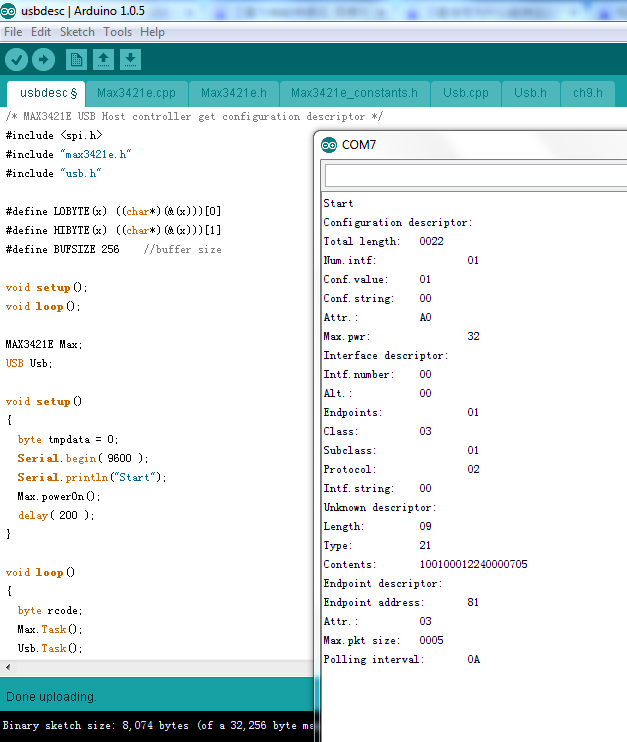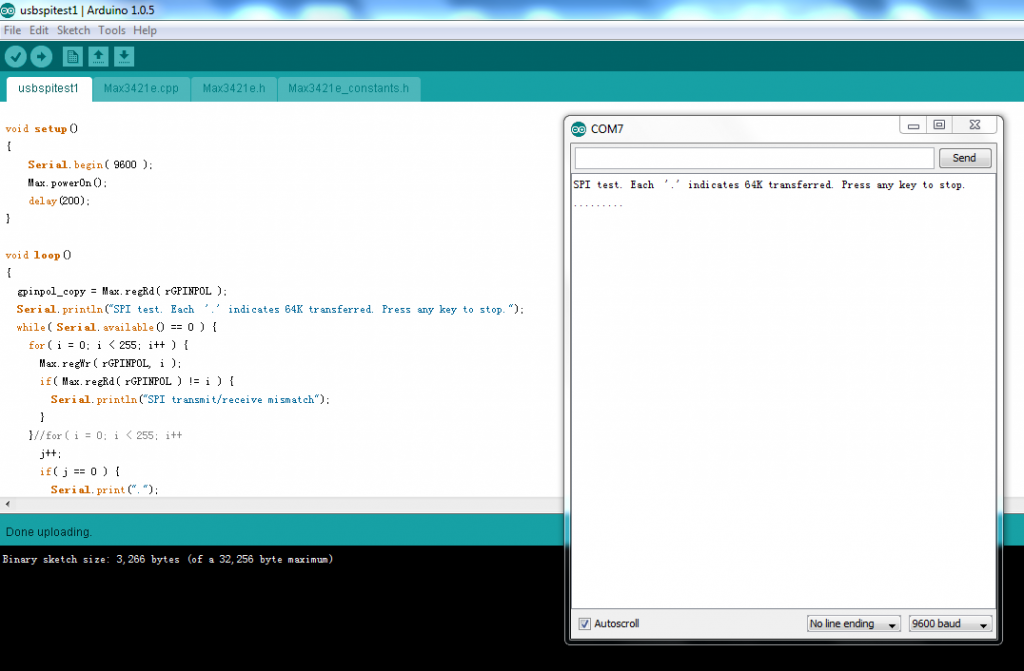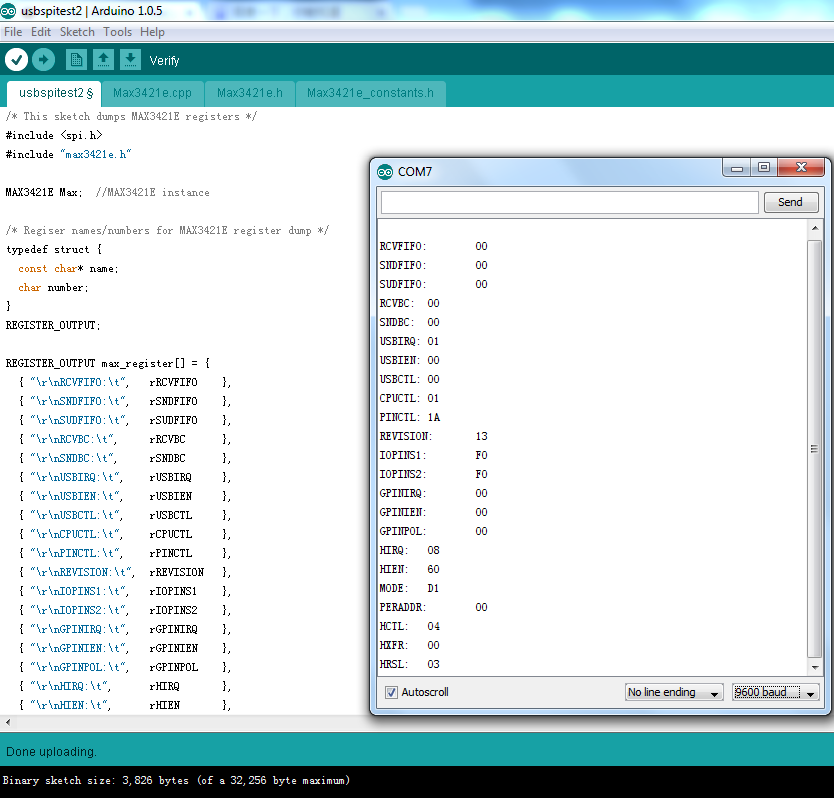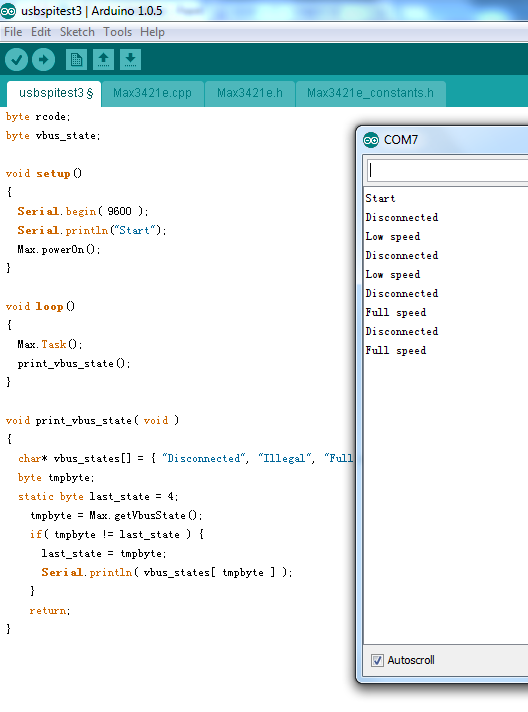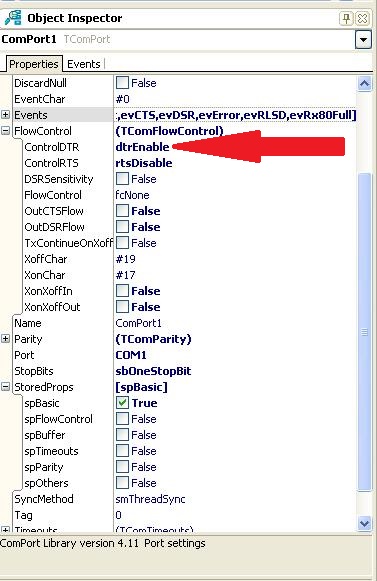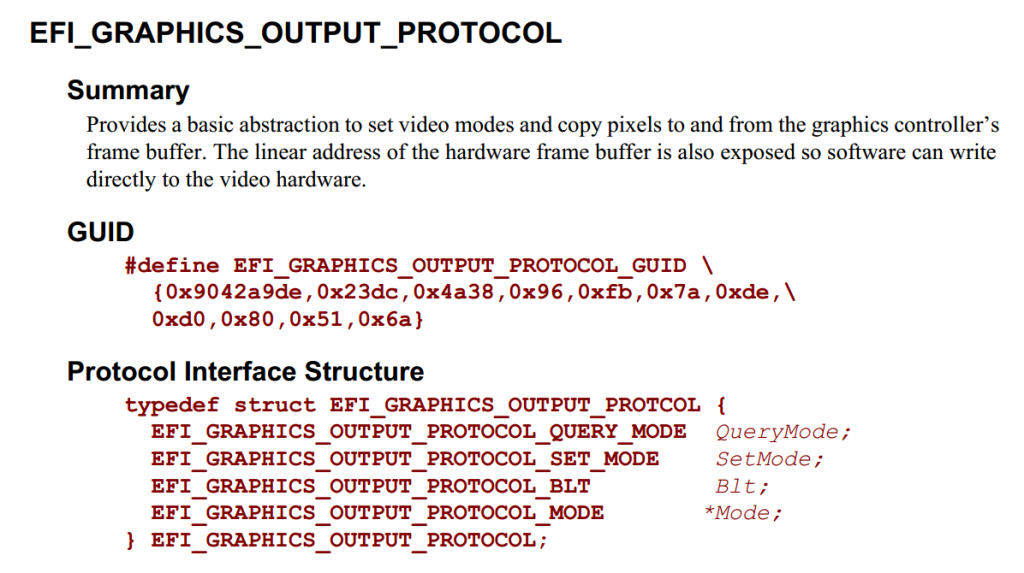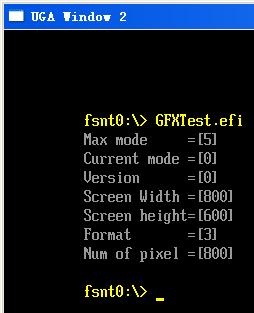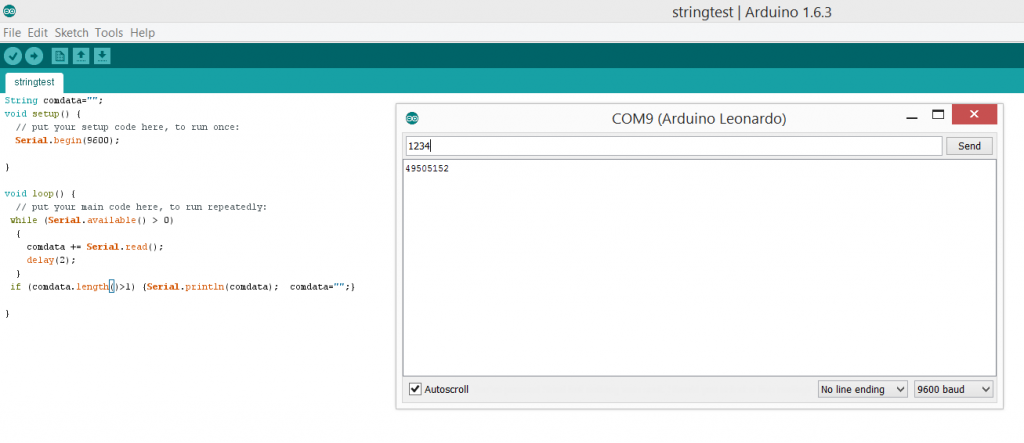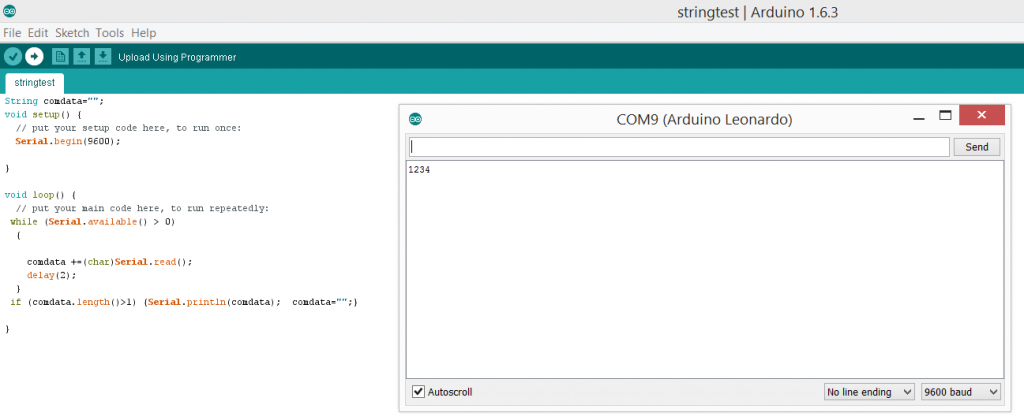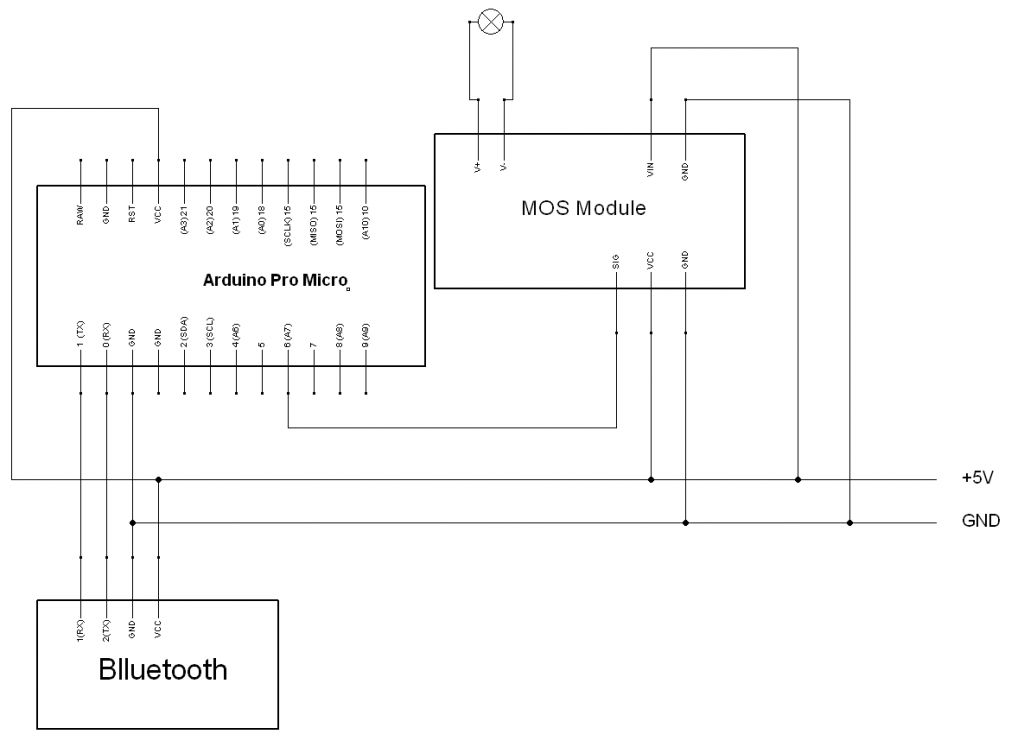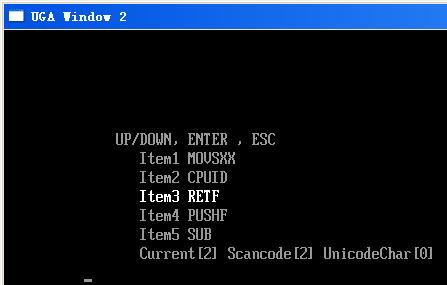对于USB设备来说,最重要的莫过于描述符。这里介绍如何获得描述符,以及部分描述符的含义。
程序来自http://www.circuitsathome.com/mcu/arduino-usb-host-part-3-descriptors
/* MAX3421E USB Host controller get configuration descriptor */
#include <spi.h>
#include "max3421e.h"
#include "usb.h"
#define LOBYTE(x) ((char*)(&(x)))[0]
#define HIBYTE(x) ((char*)(&(x)))[1]
#define BUFSIZE 256 //buffer size
void setup();
void loop();
MAX3421E Max;
USB Usb;
void setup()
{
byte tmpdata = 0;
Serial.begin( 9600 );
Serial.println("Start");
Max.powerOn();
delay( 200 );
}
void loop()
{
byte rcode;
Max.Task();
Usb.Task();
if( Usb.getUsbTaskState() >= 0x80 ) { //state configuring or higher
rcode = getconfdescr( 1, 0 ); //get configuration descriptor
if( rcode ) {
Serial.println( rcode, HEX );
}
while( 1 ); //stop
}
}
byte getconfdescr( byte addr, byte conf )
{
char buf[ BUFSIZE ];
char* buf_ptr = buf;
byte rcode;
byte descr_length;
byte descr_type;
unsigned int total_length;
rcode = Usb.getConfDescr( addr, 0, 4, conf, buf ); //get total length
LOBYTE( total_length ) = buf[ 2 ];
HIBYTE( total_length ) = buf[ 3 ];
if( total_length > 256 ) { //check if total length is larger than buffer
Serial.println("Total length truncated to 256 bytes");
total_length = 256;
}
rcode = Usb.getConfDescr( addr, 0, total_length, conf, buf ); //get the whole descriptor
while( buf_ptr < buf + total_length ) { //parsing descriptors
descr_length = *( buf_ptr );
descr_type = *( buf_ptr + 1 );
switch( descr_type ) {
case( USB_DESCRIPTOR_CONFIGURATION ):
printconfdescr( buf_ptr );
break;
case( USB_DESCRIPTOR_INTERFACE ):
printintfdescr( buf_ptr );
break;
case( USB_DESCRIPTOR_ENDPOINT ):
printepdescr( buf_ptr );
break;
default:
printunkdescr( buf_ptr );
break;
}//switch( descr_type
buf_ptr = ( buf_ptr + descr_length ); //advance buffer pointer
}//while( buf_ptr <=...
return( 0 );
}
/* prints hex numbers with leading zeroes */
// copyright, Peter H Anderson, Baltimore, MD, Nov, '07
// source: http://www.phanderson.com/arduino/arduino_display.html
void print_hex(int v, int num_places)
{
int mask=0, n, num_nibbles, digit;
for (n=1; n<=num_places; n++) {
mask = (mask << 1) | 0x0001;
}
v = v & mask; // truncate v to specified number of places
num_nibbles = num_places / 4;
if ((num_places % 4) != 0) {
++num_nibbles;
}
do {
digit = ((v >> (num_nibbles-1) * 4)) & 0x0f;
Serial.print(digit, HEX);
}
while(--num_nibbles);
}
/* function to print configuration descriptor */
void printconfdescr( char* descr_ptr )
{
USB_CONFIGURATION_DESCRIPTOR* conf_ptr = ( USB_CONFIGURATION_DESCRIPTOR* )descr_ptr;
Serial.println("Configuration descriptor:");
Serial.print("Total length:\t");
print_hex( conf_ptr->wTotalLength, 16 );
Serial.print("\r\nNum.intf:\t\t");
print_hex( conf_ptr->bNumInterfaces, 8 );
Serial.print("\r\nConf.value:\t");
print_hex( conf_ptr->bConfigurationValue, 8 );
Serial.print("\r\nConf.string:\t");
print_hex( conf_ptr->iConfiguration, 8 );
Serial.print("\r\nAttr.:\t\t");
print_hex( conf_ptr->bmAttributes, 8 );
Serial.print("\r\nMax.pwr:\t\t");
print_hex( conf_ptr->bMaxPower, 8 );
return;
}
/* function to print interface descriptor */
void printintfdescr( char* descr_ptr )
{
USB_INTERFACE_DESCRIPTOR* intf_ptr = ( USB_INTERFACE_DESCRIPTOR* )descr_ptr;
Serial.println("\r\nInterface descriptor:");
Serial.print("Intf.number:\t");
print_hex( intf_ptr->bInterfaceNumber, 8 );
Serial.print("\r\nAlt.:\t\t");
print_hex( intf_ptr->bAlternateSetting, 8 );
Serial.print("\r\nEndpoints:\t\t");
print_hex( intf_ptr->bNumEndpoints, 8 );
Serial.print("\r\nClass:\t\t");
print_hex( intf_ptr->bInterfaceClass, 8 );
Serial.print("\r\nSubclass:\t\t");
print_hex( intf_ptr->bInterfaceSubClass, 8 );
Serial.print("\r\nProtocol:\t\t");
print_hex( intf_ptr->bInterfaceProtocol, 8 );
Serial.print("\r\nIntf.string:\t");
print_hex( intf_ptr->iInterface, 8 );
return;
}
/* function to print endpoint descriptor */
void printepdescr( char* descr_ptr )
{
USB_ENDPOINT_DESCRIPTOR* ep_ptr = ( USB_ENDPOINT_DESCRIPTOR* )descr_ptr;
Serial.println("\r\nEndpoint descriptor:");
Serial.print("Endpoint address:\t");
print_hex( ep_ptr->bEndpointAddress, 8 );
Serial.print("\r\nAttr.:\t\t");
print_hex( ep_ptr->bmAttributes, 8 );
Serial.print("\r\nMax.pkt size:\t");
print_hex( ep_ptr->wMaxPacketSize, 16 );
Serial.print("\r\nPolling interval:\t");
print_hex( ep_ptr->bInterval, 8 );
return;
}
/*function to print unknown descriptor */
void printunkdescr( char* descr_ptr )
{
byte length = *descr_ptr;
byte i;
Serial.println("\r\nUnknown descriptor:");
Serial. print("Length:\t\t");
print_hex( *descr_ptr, 8 );
Serial.print("\r\nType:\t\t");
print_hex( *(descr_ptr + 1 ), 8 );
Serial.print("\r\nContents:\t");
descr_ptr += 2;
for( i = 0; i < length; i++ ) {
print_hex( *descr_ptr, 8 );
descr_ptr++;
}
}
运行结果如下:
手工分析USB的描述符简直就是噩梦…….最好有USB逻辑分析仪【参考1】,抓包解析USB数据非常方便。
多说两句关于【参考1】背后的故事:当年,我在一家国内最大的PC组装企业工作。有一次,加拿大的客户抱怨我们卖出去的机器无法使用他们的一款USB条码枪。我们的机器是 AMD RS780系列的商用机,这个系列的特点是:价格便宜,可以支持很多显示器(如果没有记错的话,用上标准的扩展配件可以同时支持5台显示器的显示,这在当时是很牛x的技术)。只是这个芯片组经常有稀奇古怪的问题,卖出去两三年之后会有客户报告奇怪的问题(销售总是承诺售后保修很长的时间)。比如:台湾邮政的客户惊奇的发现,每天早晨这个机器开机进入桌面之后会出现黑屏闪一次的问题等等。
USB条码枪这个客诉先到前端看了差不多三个月都没有搞定,走流程到全球售后研发这边了。组里正好有一台USB逻辑分析仪,我就拿着实验了一下。最后抓取得结果是这个条码枪和芯片组有兼容性问题,在判断USB设备速度的时候,K J 握手有问题。外国人和中国人在对待问题上差别蛮大,前者通常要求你找到Root Cause,即使时间很长也可以等待,找到之后,如果不是我们的问题,他们也能接受;而后者的要求通常是不管你什么Root Cause, 马上给我个能用的方法就行。他们的逻辑简单得也令人发指,最常见的说法是,我在XXX的机器上看不到现象,那就一定是你们的问题。
只是没想到 Root Cause 找到了,客户也表示接受了,我这边反倒闯了祸。
当时我们刚换了一个Team的主管,BIOS工程师出身,管着下面八九个人。据他所知,在 RS780 芯片组USB配置空间上有个寄存器,可以显示当前某个USB口上是否有USB设备插入。这个寄存器是 RS780芯片组特有的。这个主管坚持非要我去检查这个位是否设置起来。我说,逻辑分析仪结果都抓出来了还看啥啊? 最主要是我太懒了,看问题不一定花时间,但是找机器走流程装系统之类的很麻烦。一番话下去,主管为了不再暴露他对USB的无知,没再说下去,只是脸色变得铁青。从技术的角度来说,我的解释没有办法反驳。好比用示波器看到了波形,知道是硬件问题,Onwer肯定要换成 HW 工程师…….
最后看没看我忘记了,只是后来我在这个主管下面日子不好过了。再后来没办法自己找了个其他部门跑路了,办理转部门的时候这个主管非常“遗憾”的拖了我很久才撒手…….
这个故事告诉我们:
1. AMD 的芯片组不稳定啊!
2. 谦虚谨慎根据情况装孙子很重要,特别是国企类型的企业
3. 懂一半的领导比什么都不懂的更麻烦。
就是这样。
参考:
1.http://www.lab-z.com/wp-content/uploads/2013/02/usbhs.pdf 关于 USB 高速(HighSpeed)和中速(FullSpeed)的区分
